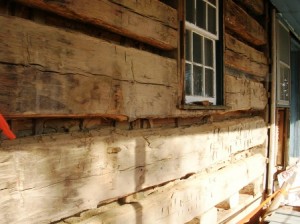By 1850 the Shenandoah Valley was the largest wheat producing region in the United States. In 1864 this cabin survived what historians call “The Burning”. That’s when Union General Phillip Sheridan swept through the Valley burning the barns, mills and cabins to help end the American Civil War. Within site of this cabin the Yankees burned down the original Swoope Mill which used water from Middle River for power.
-
It’s interesting that we are taught to think of history through people and buildings, but the deepest, most telling history is often natural. Eloquently written, I enjoyed it.
-
Just curious, Theoretically if it had never been cut down, and survived the many disruptive events of American history, is it possible for that tree to have lived all 393 years of its life before being burned?
-
Yes, it is quite possible that the Oak could have lived and still be standing. The Wye Oak in Maryland lived 463 years before it was destroyed and it wasn’t the oldest Oak around. It was the biggest.
-
Bobby, This is pretty awesome! When you think about how a tree gives, and gives, and gives, and gives. The story reminds me of one of my favorite books titled The Giving Tree. And just think, the big old oak log has not retired; it just keeps on working 🙂
-
This was a great story and tie to history. Many times as I have admired old trees I envision who among our ancestors or historians may have passed by, what animals and birds have laid there in the shade or been among their branches and what weather events and disasters such as fire have they experienced. When you see some of these large trees in urban areas you wonder about everything that has taken place around them and how they survived. The same holds true for the antique wooden furniture in our homes and the trees they once were. If they could speak or had cameras to record what they witnessed we would be amazed at the wonderful stories they could tell and show. Thanks for your thoughts Bobby.
Leave a ReplyYour email is safe with us.
Cancel Reply
-
“Bobby is a force of nature! And with this compilation of his blog posts, musings, and articles, we gain insight into farming, family, and the forces that shape the Shenandoah Valley he calls home. I enjoyed his humorous yet direct writing style as he shared personal and professional observations on conserving the natural landscapes that, quite literally, feed and nourish us.”
Recent Posts
Blog Post Categories
- Atlantic Coast Pipeline
- Birding
- Cattle Farming
- Chesapeake Bay
- Climate Change
- Conservation Easements
- Endangered Species
- Environmental Justice
- Herd Health
- Hydrofracking
- Invasive Species
- Nature
- Nutrient Management
- Quail Habitat
- Renewable Energy
- Riparian Buffers
- Riparian Forest Buffers Ebook
- Soil and Water Conservation
- Soil Erosion
- Solar
- Stream Fencing
- Swoope Almanac
- Trees
- Uncategorized
- Val Our Border Collie
- Water Pollution
- Watershed restoration
- Whiskey Creek
- Whiskey Creek Almanac
- Whiskey Creek Angus
- Whiskey Creek Angus
- Whiskey Creek Regenerative Farming
- Wildlife






5 Comments
Leave your reply.